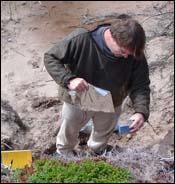 |
|
CollaborationsThis page provides the names and brief biographies of scholars who are collaborating with Dr. Rankin in her research. Dr. Richard L. Josephs Dr. Richard L. Josephs is an assistant professor in the Department of Geology and Geological Engineering, University of North Dakota. His area of research specialization is geoarchaeology (archaeological geology) - the application of geoscience methods of investigation to archaeological research. The primary technique used by Dr. Josephs to investigate archaeological sites is micromorphology - the study of undisturbed soil or sediment in thin section.
For the past four years, Dr. Josephs has been working closely with student and faculty members from The Archaeology Unit at sites throughout Labrador. His primary task has been to reconstruct the paleoenvironment at the time of occupation. At two Intermediate Amerindian sites near Goose Bay, the focus was the location and interpretation of each site with respect to the paleoshoreline of western Hamilton Inlet, ca. 3000 B.P.
Along Porcupine Strand, the objective is finding evidence that will help to explain the sudden disappearance of the Maritime Archaic Tradition from the archaeological record, sometime between 4000 and 3500 B.P. In the vast Western Interior of the province, the goal is to find, excavate, and analyze sites in an effort to correct the coastally-biased view of Labrador culture-history. Geoarchaeological investigations along the western shoreline of Ashuanipi Lake, east of Labrador City, are providing evidence about shoreline stability during the mid- to late Holocene that will impose temporal and spatial constraints regarding human occupation in this area.
For additional information, you are encouraged to visit Dr. Josephs' web page at: http://www.geology.und.edu/josephs/josephs.html Updated November, 2007 |


